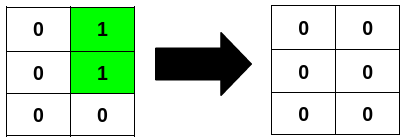LeetCode-in-Java
3240. Minimum Number of Flips to Make Binary Grid Palindromic II
Medium
You are given an m x n binary matrix grid.
A row or column is considered palindromic if its values read the same forward and backward.
You can flip any number of cells in grid from 0 to 1, or from 1 to 0.
Return the minimum number of cells that need to be flipped to make all rows and columns palindromic, and the total number of 1’s in grid divisible by 4.
Example 1:
Input: grid = [[1,0,0],[0,1,0],[0,0,1]]
Output: 3
Explanation:

Example 2:
Input: grid = [[0,1],[0,1],[0,0]]
Output: 2
Explanation:

Example 3:
Input: grid = [[1],[1]]
Output: 2
Explanation:

Constraints:
m == grid.lengthn == grid[i].length1 <= m * n <= 2 * 1050 <= grid[i][j] <= 1
Solution
public class Solution {
public int minFlips(int[][] grid) {
int res = 0;
int one = 0;
int diff = 0;
int m = grid.length;
int n = grid[0].length;
// Handle quadrants
for (int i = 0; i < m / 2; ++i) {
for (int j = 0; j < n / 2; ++j) {
int v =
grid[i][j]
+ grid[i][n - 1 - j]
+ grid[m - 1 - i][j]
+ grid[m - 1 - i][n - 1 - j];
res += Math.min(v, 4 - v);
}
}
// Handle middle column
if (n % 2 > 0) {
for (int i = 0; i < m / 2; ++i) {
diff += grid[i][n / 2] ^ grid[m - 1 - i][n / 2];
one += grid[i][n / 2] + grid[m - 1 - i][n / 2];
}
}
// Handle middle row
if (m % 2 > 0) {
for (int j = 0; j < n / 2; ++j) {
diff += grid[m / 2][j] ^ grid[m / 2][n - 1 - j];
one += grid[m / 2][j] + grid[m / 2][n - 1 - j];
}
}
// Handle center point
if (n % 2 > 0 && m % 2 > 0) {
res += grid[m / 2][n / 2];
}
// Divisible by 4
if (diff == 0 && one % 4 > 0) {
res += 2;
}
return res + diff;
}
}

